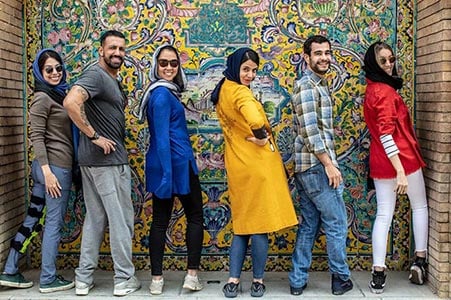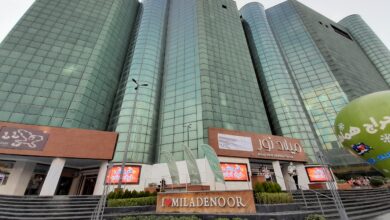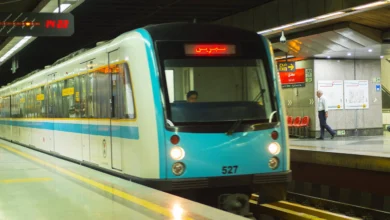Saadabad Complex: Everything You Need to Know
A Captivating Blend of History, Culture, and Natural Beauty

You haven’t really experienced Tehran without visiting the magnificent Saadabad Palace Complex. The Saadabad complex was one of the summer residences of the Qajar and Pahlavi monarchs. It is currently one of Tehran’s major tourist attractions.
Here’s a look at the Saadabad complex, a historic and culturally important site known for its lush gardens and surrounding greenery.
Contents
History of Saadabad Palace
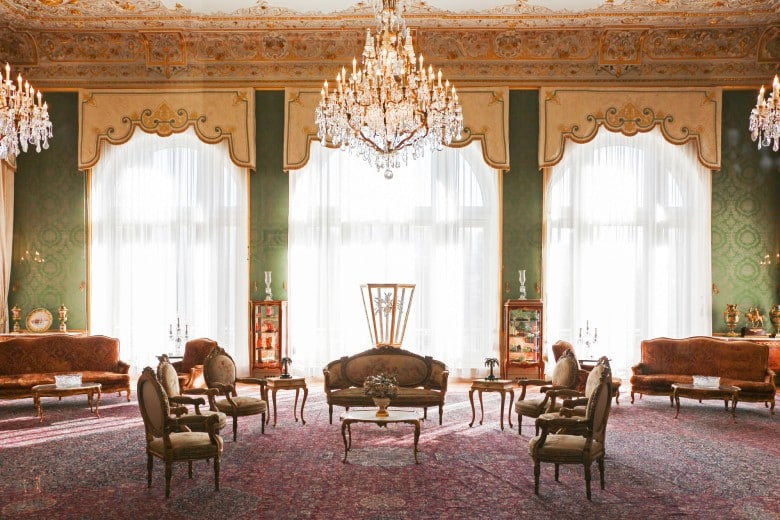
What we now know as Saadabad Palace and Gardens was once a small summer retreat in Shemiran’s foothills. Tehran expanded over time, and the area eventually became part of the city.
Saadabad Palace has borne witness to three major historical eras:
- Qajar Era (1785-1925) Originally built as a summer residence for Qajar royalty, the oldest structure dates back to Ahmad Shah Qajar.
- Pahlavi Era (1925-1979) Reza Shah Pahlavi claimed parts of Saadabad after coming to power. He renovated existing buildings and constructed new palaces across the complex. During his rule, it hosted important political affairs. Mohammad Reza Pahlavi, his son, then inherited the throne. More palaces were added as the Pahlavi family grew over time.
- Post-Revolution (1979-Present) On Imam Khomeini’s orders, Saadabad was converted into a public museum after the 1979 Islamic Revolution, offering insight into royal lifestyles. It is still used for official state functions and is open to the public.
Saadabad Palace Complex Architecture

Saadabad Palace blends European and traditional Persian architectural styles across its palaces and structures.
The complex spans 300 hectares in total. About 110 hectares are occupied by the palace buildings themselves. The remaining 180 hectares encompass vast gardens, underground aqueducts, and greenhouses.
Renowned Iranian and international architects designed each palace. Materials like marble, stucco, tile, and mirrorwork were used artfully to construct and decorate the interiors. The palaces feature both classical and modern designs.
For example, the White Palace has four Roman-style columns on its facade. The Green Palace was named “Marble Palace” for its decorative green marble front.
Various palaces, from the early Qajar era to the Pahlavi dynasty, were built over time. Each structure has its unique architecture and history that we will explore later.
Museums and Palaces of Saadabad Complex
After the 1979 Iranian Revolution, many Saadabad palaces were converted into public museums:
The White Palace Museum

The White Palace, also known as Mellat Palace, has the most significant footprint among Saadabad palaces. It served as the summer residence of Mohammad Reza Shah Pahlavi and his wife, Farah. Construction began in 1931 on Reza Shah’s orders and lasted about five years.
Mohammad Reza Shah had his office here, and it housed the administrative affairs and ceremonies of the royal court.
Some prominent surviving works include large oil paintings by Master Behzad and his students. It also contains fine Persian rugs, historical ceramics, valuable crystals, European chandeliers and sconces, and a writing desk belonging to Marie Antoinette, the last Queen of France before the revolution.
The Black Palace Museum

Called the Black Palace for its dark marble cladding, this visually striking building occupies the southernmost section of Saadabad grounds. From 1967-78, it served as the residence of the Minister of the Royal Court. In 1982, it was inaugurated as the Museum of Fine Arts.
Shams Pahlavi Palace Museum
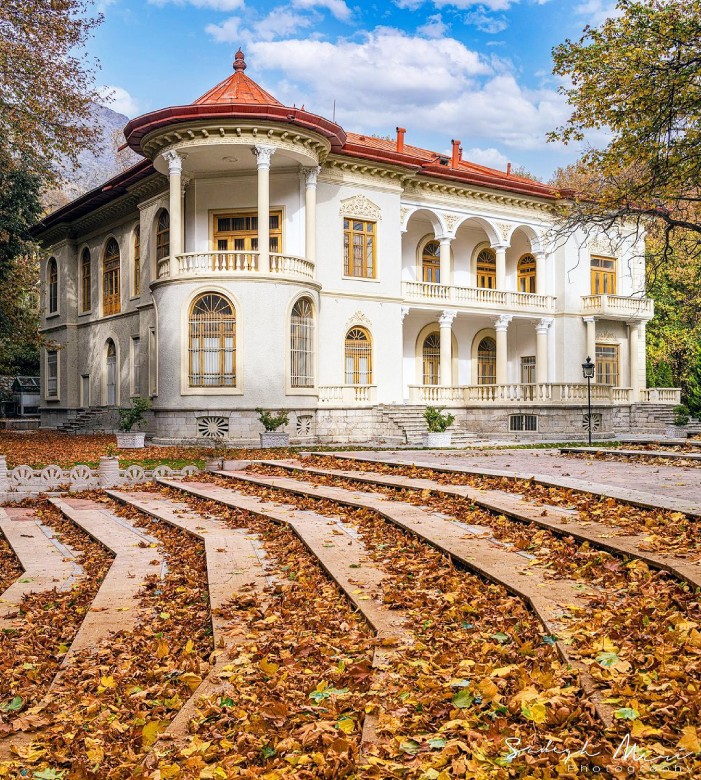
Located in Saadabad’s northwest corner, Shams Palace now houses a rich, expansive museum documenting the evolution of mankind. It also displays Empress Farah’s royal dresses in the Museum of Royal Clothing.
The Ashraf Palace Museum

Now known as the Museum of Royal Dinnerware, Ashraf Palace occupies Saadabad’s eastern grounds.
Queen Mother’s Palace
Now called the Assembly Building, this former residence of Taj ol-Molouk, Reza Shah’s mother, is used to host foreign dignitaries of the Iranian government. Off-limits to the general public, it lies adjacent to the administrative headquarters of the Saadabad complex.
Bahman Palace

The Bahman Palace was built during the reign of Mohammad Reza Shah. This building is considered one of the most beautiful structures in Sa’dabad Complex. It was the residence of the Shah’s nephew and son of Gholam Reza Pahlavi.
Currently, Bahman Palace houses the administration offices of Sa’dabad Complex.
Shahram Palace

Formerly the residence of Taj al-Molouk, second wife of Reza Shah and later Shahram, son of Ashraf Pahlavi. Shahram Palace has also been transformed into a military museum in the center of Sa’dabad Complex.
Former Crown Prince Reza Pahlavi Palace
The Old Crown Prince Palace is also known as Karbas Palace. Initially, this palace was the workplace and retreat of Reza Shah Pahlavi; however, after his dismissal during the second Pahlevi era, his grandson Reza Pahlavi used the Karbas Palace.
Farah Pahlavi Palace

The building of this palace is located at the northernmost point of the Sa’dabad Complex and has beautiful and unique architecture. From 2006 to the present, various exhibitions of traditional clothing and fashion have been held in this building.
Leila Pahlavi Palace
The Leila Palace building, located in the center of the Sa’dabad complex in Tehran, is the last palace built in this complex.
Omidvar Brothers Museum

The building of the Omidvar Brothers Museum in the northwest of Sa’dabad Complex dates back to the Qajar era. Some palace attendants and guards used to rest here, and carriages of the royal court were kept in this section. The Omidvar brothers were the first Iranian world travelers who began their journey around the world in 1954. Their valuable historical artifacts are kept in this museum, and the collection is open to the public.
Other Palaces and Museums
Additional museums include the Royal Albums and Documents Museum at the old Imperial Guards building, the Royal Kitchen Museum inside Mellat Palace, the Water Museum, and the Royal Automobiles Museum. The Gholamreza Pahlavi Palace is now the Royal Arms Museum.
Saadabad Aqueducts
The Darband River once flowed through the Saadabad garden, making Shemiran lush and verdant. However, the expanding gardens and plantations under Reza Shah necessitated irrigation aqueducts to water the trees. Hence, twelve underground aqueducts were built throughout Saadabad – some still flow silently.
Sa’dabad Palace Amenities
For visitors’ convenience, Sa’dabad Palace offers suitable amenities, including:
- Prayer Room
- Qajar Photo Studio
- Sports Park
- Mellat Palace Cinema Hall for Conventions
- Radio Station
- Café & Restaurant
- Garden Transport Service
- Restrooms
- Benches
- Library
- Art Center for Independent Art Activities
The Gates of Sa’dabad Palace

Due to the vastness of Sa’dabad Garden and its access to various surrounding gardens, gates were installed all around the historic Sa’dabad complex, of which currently only the Zaferanieh Street and Darband Street gates are open to tourists.
The list of gates of the Sa’dabad Palace complex is as follows:
- Nizamieh Gate (the former route of access for Reza Shah Pahlavi)
- Zaferanieh Gate
- Darband Street Gate (the former route of access for Mohammad Reza Pahlavi)
- Darband Square Gate
- Two Ja’farabad Gates
- River Gate
- White Palace Gate
Where is Sa’dabad Palace in Tehran?
The Sa’dabad complex is located in the northern part of Tehran at the foothills of Tochal mountain. The Sa’dabad complex is surrounded by the northern districts of Niyavaran to the east, Velenjak to the west, and Tajrish to the south.
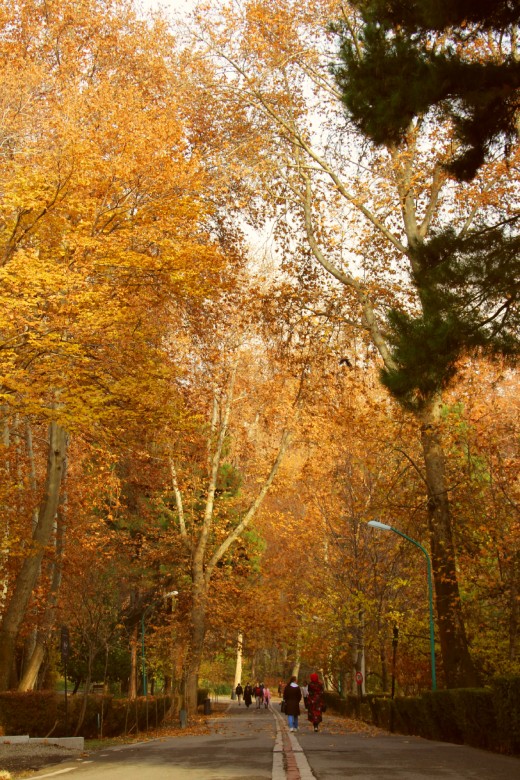
Saadabad Palace Opening Hours
Sa’dabad Palace’s opening hours are from 9 AM to 7 PM during Spring and Summer and from 8 AM to 5 PM during fall and winter, owing to colder weather and earlier nightfall.
If you plan on buying tickets on-site, the ticket booths are open until 5:30 PM during Spring and Summer and until 3:30 PM during fall and winter.
Nearby Attractions to Sa’dabad Palace
While it’s unlikely you’ll have spare time after wandering Sa’dabad’s grounds, we’ll still introduce some of the top nearby attractions to visit if you do:
Tajrish Bazaar

Tajrish’s old-world traditional bazaar and ambiance make it one of Tehran’s top sights – it holds novelty for all. This covered the market’s age-old shops, the hustle and bustle of shoppers, and the sound of the call to prayer from the Emamzadeh Saleh shrine across the way, which offers a singular experience. Tajrish Bazaar has around 400 stores selling vegetables, fruits, copperware, apparel, spices, and more.
Dr. Hesabi Museum

Essentially, the house of this renowned scientist was turned into a museum after he died in 1993, becoming one of Tehran’s attractions. Located on the third floor of Dr. Hesabi’s home, close to Sa’dabad Palace, the museum displays his personal belongings, medals, honors, writings, academic documents, old photos, and more for public viewing.
Ferdows Garden

A large traditional Persian garden with a historic mansion dating to the Qajar era, today, Ferdows Garden also houses Iran’s Cinema Museum, offering opportunities for admiring nature and traditional architecture along with the cinema museum.
Final Words
The beautiful Saadabad Palace tells the story of Iran’s history. Its gardens and buildings show what life was like for Iran’s royal families. Walking around Saadabad lets visitors go back and imagine life in the palace long ago. From its small beginnings as a summer home to the grand buildings there today, Saadabad has many great things to see. Its fancy palaces and museums make visiting Saadabad a must for anyone who wants to learn about Iran’s royal past. Come visit this fantastic palace!
